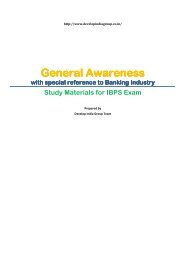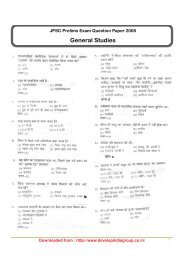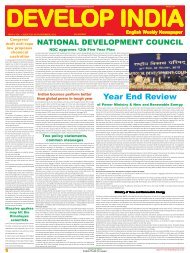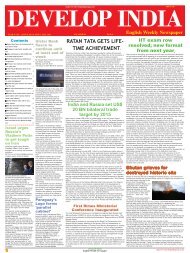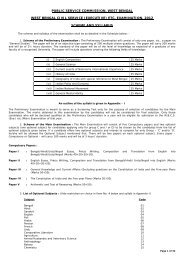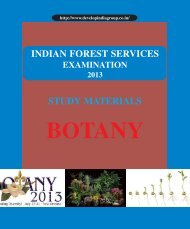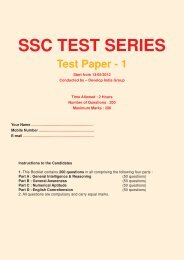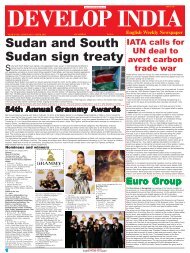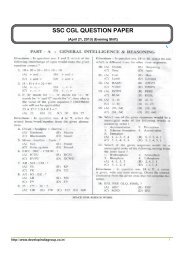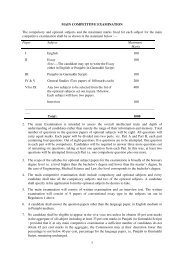Develop India Year 5, Vol. 1, Issue 243, 31 March - 7 April, 2013.pmd
Develop India Year 5, Vol. 1, Issue 243, 31 March - 7 April, 2013.pmd
Develop India Year 5, Vol. 1, Issue 243, 31 March - 7 April, 2013.pmd
You also want an ePaper? Increase the reach of your titles
YUMPU automatically turns print PDFs into web optimized ePapers that Google loves.
DEVELOP INDIA English Weekly Newspaper<br />
Allahabad; Sunday; <strong>Develop</strong> <strong>India</strong> <strong>Year</strong> 5, <strong>Vol</strong>. 1, <strong>Issue</strong> <strong>243</strong>, <strong>31</strong> <strong>March</strong> - 7 <strong>April</strong>, 2013<br />
Microbes Thrive in Deepest<br />
Spot on Earth<br />
The deepest oceanic trench on Earth is home to a surprisingly active community of bacteria,<br />
suggesting other trenches may be hotspots of microbial life, researchers say.<br />
Life in the deep ocean often relies on organic matter snowing down from above. As these<br />
particles waft down, their nutrients get degraded by microbes attached to them, so only 1<br />
to 2 percent of the organic matter produced in surface waters is expected to make it to the<br />
average ocean depth of about 12,150 feet (3,700 meters). Just how much makes it to the<br />
very deepest parts is unknown.<br />
To learn more about life in the dirt at the ocean's depths, scientists used a submersible<br />
lander to analyze mud from the surface of Challenger Deep, the deepest spot of the Mariana<br />
Trench at the bottom of the central west Pacific Ocean. This 36,000-foot-deep (11,000 m)<br />
trench is the deepest known point on Earth's surface.<br />
'Germ Islands' Found Floating in Ocean<br />
Bacteria and other germs latch on to clumps of decaying matter floating in the ocean, creating<br />
"germ islands" that could spread disease, a new study reveals.<br />
When plants and animals near the surface of the ocean die, they decay and gradually fall to<br />
the seafloor. This dead matter can clump together with sand, soot, fecal matter and other<br />
material to form what is called "marine snow," so named because it looks like tiny bits of<br />
white fluff. Marine snow continuously rains down on the deep ocean, feeding many of the<br />
creatures that dwell there.<br />
A group of scientists studying marine snow found that these clumps, or aggregates, may act<br />
as island-like refuges for pathogens, the general term for disease-causing organisms or germs,<br />
such as bacteria and viruses. (The "island" term comes from the comparison of the existence<br />
of pathogens on marine snow with the way insects, amphibians and other creatures<br />
establish homes and persist on remote islands in the oceans.)<br />
The scientists are evaluating the degree to which aggregates made up of this decaying organic<br />
matter provide a favorable microclimate for aquatic pathogens. These "refuges" seem<br />
to protect pathogens from stressors, such as sunlight and salinity (amount of salt in the<br />
water) changes, and from predators. They also might provide sources of nourishment for<br />
the pathogens.<br />
"If the microclimate is favorable, aggregates likely facilitate the persistence, prevalence and<br />
dispersal of aquatic pathogens," said study team member Fred Dobbs of Old Dominion<br />
University (ODU) in Norfolk, Va.<br />
The researchers found the bacteria had an increased metabolism (meaning they were more<br />
active), and a greater diversity, when living on individual organic aggregates compared with<br />
those in the surrounding water. These results indicate that aggregates might be potential<br />
reservoirs and vectors for aquatic pathogens.<br />
"We've shown, for example, that vibrios [a type of pathogen] proliferate in aggregates and<br />
decline in adjacent, aggregate-free water," the authors wrote in the paper describing their<br />
findings, which is included in the May 4 issue of the journal Aquatic Microbial Ecology.<br />
Current models developed to look at the transmission of waterborne diseases and illnesses,<br />
however, don't consider the benefits microorganisms gain from hitching a ride on marine<br />
snow.<br />
This detritus may skew water-sampling procedures and mathematical models used to predict<br />
the transmission of waterborne diseases to humans. When water sampling is conducted<br />
— to determine whether recreational waters should be open to swimmers, or whether<br />
shellfish beds should be closed to fishers — aggregates lend a hit-or-miss aspect to the<br />
testing.<br />
A sample might include only water without aggregates, giving false-negative results that no<br />
danger exists.<br />
"The presence or absence of a single aggregate in an environmental water sample could<br />
drastically alter the measure of bacterial concentrations," Dobbs said.<br />
The scientists are using the information they have gathered to help predict "how long bacteria<br />
can thrive on an individual aggregate and the relationship between the size of the<br />
aggregate and the diversity of species found on it," said lead author of the study Maille<br />
Lyons, also of ODU.<br />
Japanese architect Toyo Ito<br />
wins Pritzker Prize<br />
Japanese architect Toyo Ito, whose buildings have been praised for their fluid beauty and<br />
balance between the physical and virtual world, has won the 2013 Pritzker Architecture<br />
Prize, the prize's jury announced Sunday.<br />
The 71-year-old architect joins such masters as Frank Gehry, I.M. Pei, Tadao Ando, Renzo<br />
Piano and Wang Su in receiving the honor that's been called architecture's Nobel Prize. Ito,<br />
the sixth Japanese architect to receive the prize, was recognized for the libraries, houses,<br />
theaters, offices and other buildings he has designed in Japan and beyond.<br />
He accepted the honor by saying that whenever he's done designing a building, he becomes<br />
"painfully aware of my own inadequacy, and it turns into energy to challenge the<br />
next project."<br />
"Therefore, I will never fix my architectural style and never be satisfied with my works," he<br />
said in a statement.<br />
"Toyo Ito's architecture has improved the quality of both public and private spaces," said<br />
U.S. Supreme Court Justice Stephen Breyer, who served on the Pritzker Prize jury.<br />
"It has inspired many architects, critics and members of the general public alike. Along with<br />
all others involved with the Pritzker Prize, I am very pleased that he has received the award,"<br />
Breyer said in a statement.<br />
Some of Ito's notable creations include the curvaceous Municipal Funeral Hall in Gifu, Japan;<br />
the transparent Sendai Mediatheque library in Miyagi, Japan; the arch-filled Tama Art<br />
University Library in suburban Tokyo; the spiral White O residence in Marbella, Chile; and<br />
the angular 2002 Serpentine Gallery Pavilion in London.<br />
"His buildings are complex, yet his high degree of synthesis means that his works attain a<br />
level of calmness, which ultimately allows the inhabitants to freely develop their life and<br />
activities in them," said Chilean architect and Pritzker Prize jury member Alejandro Aravena.<br />
Ito began his career at Kiyonori Kikutake & Associates after he graduated from Tokyo University<br />
in 1965. He founded his own architecture firm in 1971. His works have been exhibited<br />
in museums in the United States, England, Denmark, Italy, Chile and numerous cities in<br />
Japan.<br />
Ito will receive a $100,000 grant and a bronze medallion at the formal Pritzker ceremony<br />
May 29 at the John F. Kennedy Presidential Library and Museum in Boston.<br />
Sponsored by the Hyatt Foundation, the Pritzker Prize was established in 1979 by the late<br />
entrepreneur Jay A. Pritzker and his wife, Cindy, to honor "a living architect whose built<br />
work demonstrates a combination of those qualities of talent, vision and commitment, which<br />
has produced consistent and significant contributions to humanity and the built environment<br />
through the art of architecture."<br />
The Pritzker family founded the prize because of its involvement with developing Hyatt<br />
Hotel properties around the world and because architecture was not included in the Nobel<br />
Prizes. The Pritzker selection process is modeled after the Nobels.<br />
Argentina's Fernandez raises<br />
Falklands with Pope Francis<br />
Argentine President Cristina Fernandez de Kirchner says she has asked for the Pope's intervention<br />
in the Falklands dispute between her country and the UK. Visiting the Vatican, Ms<br />
Fernandez said she had asked the Pope to promote dialogue between the two sides.<br />
Argentine Pope Francis was elected last week and will be formally installed as pontiff at a<br />
Mass on.<br />
In the past he has said the Falkland Islands, a UK overseas territory, belong to Argentina.<br />
Before Cardinal Jorge Mario Bergoglio was elected, the 76-year-old was Archbishop of Buenos<br />
Aires. Relations between him, Ms Fernandez, and her late husband and predecessor as president,<br />
Nestor Kirchner, were tense.<br />
"I asked for his intervention to avoid problems that could emerge from the militarization of<br />
Great Britain in the south Atlantic," Ms Fernandez told reporters after a 15-20 minute meeting<br />
and lunch with the Pope.<br />
"We want a dialogue and that's why we asked the pope to intervene so that the dialogue is<br />
successful."<br />
In a referendum held a week ago, people in the Falkland Islands voted overwhelmingly in<br />
favour of remaining a UK overseas territory.<br />
At a Mass last year, he told Argentine veterans of the Falklands War: "We come to pray for<br />
all who have fallen, sons of the Homeland who went out to defend their mother, the Homeland,<br />
and to reclaim what is theirs."<br />
British Prime Minister David Cameron said last week that he "respectfully" disagreed with<br />
the view expressed in the past by Pope Francis that the Falkland Islands had been "usurped"<br />
by the UK.<br />
Ms Fernandez is the first head of state the new Pope has met. She presented him with a<br />
mate gourd and straw for drinking traditional Argentine tea.<br />
The two also kissed, and Ms Fernandez remarked afterwards: "Never in my life has a pope<br />
kissed me!''<br />
She gave a muted welcome to the Pope's election. The two have clashed in the past, especially<br />
over social reforms promoted by her and her late husband in the face of Church opposition.<br />
When the then-Cardinal Bergoglio argued that gay adoptions discriminated against children,<br />
Ms Fernandez said his tone harked back to "medieval times and the Inquisition".<br />
Her husband Nestor Kirchner once referred to him as the "head of the opposition".<br />
Rwanda says warlord turned<br />
himself<br />
A U.S. State Department spokeswoman says that a wanted Congolese warlord turned himself<br />
in to the U.S. Embassy in Rwanda after years on the run. Bosco Ntaganda walked into<br />
the U.S. Embassy in Kigali on Monday and asked to be transferred to the International Criminal<br />
Court at The Hague, Netherlands, where he is wanted for war crimes.<br />
State Department spokeswoman Victoria Nuland says the U.S. is now consulting with the<br />
Rwandan government.<br />
The ICC first indicted Ntaganda in 2006 but relies on member nations to arrest suspects and<br />
Congo did not apprehend him.<br />
The allegations against Ntaganda date back to crimes allegedly committed a decade ago in<br />
northeastern Congo. However, human rights groups say Ntaganda has been implicated in<br />
other attacks on civilians in eastern Congo in recent years.<br />
First in a Tweet and later in an official communique, Rwanda's Foreign Minister and government<br />
spokeswoman Louise Mushikiwabo said, "We have just learned that Gen. Ntaganda<br />
presented himself at the U.S. Embassy early this morning."<br />
In the capital of the neighboring nation of Congo, where Ntaganda has been on the run<br />
since last year, Congolese government spokesman Lambert Mende confirmed the information:<br />
"We have learned from non-official sources that Bosco Ntaganda is at the U.S. Embassy<br />
in Kigali. We are waiting for the United States to make the news official and we are<br />
confident they will hand him over to justice."<br />
Nicknamed "The Terminator," for his ruthless actions, Ntaganda was born in Rwanda in 1973,<br />
and moved to the neighboring nation of Congo as a teenager. He was first indicted in 2006<br />
by the International Criminal Court for conscripting and using child soldiers during his time<br />
as a senior commander in a Congolese rebel group accused of terrorizing the Ituri region of<br />
eastern Congo between 2002 and 2003. He later joined and rose through the ranks of a<br />
different rebel group, the National Congress for the Defense of the People, which signed a<br />
peace accord with the Congolese government on <strong>March</strong> 23, 2009.<br />
The accord paved the way for Ntaganda and his fellow rebels to join the ranks of the regular<br />
Congolese army. He soon became one of Africa's symbols of impunity. Despite the outstanding<br />
warrant from the ICC and mounting evidence of continued abuse, he was awarded<br />
the rank of general in the Congolese army, living in an upscale villa in the eastern Congolese<br />
town of Goma, playing tennis in his spare time.<br />
Then last spring, he and his men began defecting from the Congolese army by the hundreds,<br />
claiming that the government had failed to uphold their end of the 2009 deal. They<br />
started a new rebellion, dubbed the M23, in honor of the <strong>March</strong> 23 signing of the nowdefunct<br />
2009 accord. And in November last year, the rebel group marched into and seized<br />
control of Goma, one of the most important cities in eastern Congo.<br />
Ntaganda's role in the M23 rebellion remained murky, with human rights groups accusing<br />
him of leading it, while other M23 leaders attempted to distance themselves from the wanted<br />
general.<br />
Earlier this month, M23 split into two different factions. While Ntaganda was believed to<br />
have enjoyed Rwanda's support, Rwanda's relationship with him ever since the split remains<br />
unclear.<br />
Rights groups on Monday quickly called for the U.S. embassy to hand him over to The Hague.<br />
"Bosco Ntaganda is not called 'The Terminator' for nothing. If he is at the U.S. embassy, the<br />
U.S. should immediately hand him over to the International Criminal Court for trial," said<br />
Sasha Lezhnev, senior analyst for the Enough Project in Washington, who closely follows<br />
Congo. "This would send serious signals to current and future warlords who continue to<br />
perpetrate atrocities in eastern Congo."<br />
In Congo, Henri Bora Ladyi, who works at the Conflict Resolution Center which helps demobilize<br />
child soldiers, including some who fought in Ntaganda's rebel army, said: "It's a relief,<br />
but justice must be done. We fear that he will be kept in Rwanda and won't be extradited.<br />
Now what is important is to create space so that children in the M23 can leave the movement."<br />
Curiosity Mars Rover Sees<br />
Trend in Water Presence<br />
NASA's Mars rover Curiosity has seen evidence of water-bearing minerals in rocks near<br />
where it had already found clay minerals inside a drilled rock. Last week, the rover's science<br />
team announced that analysis of powder from a drilled mudstone rock on Mars indicates<br />
past environmental conditions that were favorable for microbial life. Additional findings<br />
presented today (<strong>March</strong> 18) at a news briefing at the Lunar and Planetary Science Conference<br />
in The Woodlands, Texas, suggest those conditions extended beyond the site of the<br />
drilling.<br />
Using infrared-imaging capability of a camera on the rover and an instrument that shoots<br />
neutrons into the ground to probe for hydrogen, researchers have found more hydration of<br />
minerals near the clay-bearing rock than at locations Curiosity visited earlier.<br />
The rover's Mast Camera (Mastcam) can also serve as a mineral-detecting and hydrationdetecting<br />
tool, reported Jim Bell of Arizona State University, Tempe. "Some iron-bearing<br />
rocks and minerals can be detected and mapped using the Mastcam's near-infrared filters."<br />
Ratios of brightness in different Mastcam near-infrared wavelengths can indicate the presence<br />
of some hydrated minerals. The technique was used to check rocks in the "Yellowknife<br />
Bay" area where Curiosity's drill last month collected the first powder from the interior of a<br />
rock on Mars. Some rocks in Yellowknife Bay are crisscrossed with bright veins.<br />
"With Mastcam, we see elevated hydration signals in the narrow veins that cut many of the<br />
rocks in this area," said Melissa Rice of the California Institute of Technology, Pasadena.<br />
"These bright veins contain hydrated minerals that are different from the clay minerals in<br />
the surrounding rock matrix."<br />
The Russian-made Dynamic Albedo of Neutrons (DAN) instrument on Curiosity detects hydrogen<br />
beneath the rover. At the rover's very dry study area on Mars, the detected hydrogen<br />
is mainly in water molecules bound into minerals. "We definitely see signal variation<br />
along the traverse from the landing point to Yellowknife Bay," said DAN Deputy Principal<br />
Investigator Maxim Litvak of the Space Research Institute, Moscow. "More water is detected<br />
at Yellowknife Bay than earlier on the route. Even within Yellowknife Bay, we see significant<br />
variation."<br />
Findings presented today from the Canadian-made Alpha Particle X-ray Spectrometer (APXS)<br />
on Curiosity's arm indicate that the wet environmental processes that produced clay at<br />
Yellowknife Bay did so without much change in the overall mix of chemical elements present.<br />
The elemental composition of the outcrop Curiosity drilled into matches the composition<br />
of basalt. For example, it has basalt-like proportions of silicon, aluminum, magnesium and<br />
iron. Basalt is the most common rock type on Mars. It is igneous, but it is also thought to be<br />
the parent material for sedimentary rocks Curiosity has examined.<br />
"The elemental composition of rocks in Yellowknife Bay wasn't changed much by mineral<br />
alteration," said Curiosity science team member Mariek Schmidt of Brock University, Saint<br />
Catharines, Ontario, Canada.<br />
A dust coating on rocks had made the composition detected by APXS not quite a match for<br />
basalt until Curiosity used a brush to sweep the dust away. After that, APXS saw less sulfur.<br />
"By removing the dust, we've got a better reading that pushes the classification toward<br />
basaltic composition," Schmidt said. The sedimentary rocks at Yellowknife Bay likely formed<br />
when original basaltic rocks were broken into fragments, transported, re-deposited as sedimentary<br />
particles, and mineralogically altered by exposure to water.<br />
NASA's Mars Science Laboratory Project is using Curiosity to investigate whether an area<br />
within Mars' Gale Crater has ever offered an environment favorable for microbial life. Curiosity,<br />
carrying 10 science instruments, landed seven months ago to begin its two-year prime<br />
mission. NASA's Jet Propulsion Laboratory, Pasadena, Calif., manages the project for NASA's<br />
Science Mission Directorate in Washington.<br />
Graves of Twin Moon Probes<br />
Spotted by NASA Spacecraft<br />
An eagle-eyed NASA spacecraft has spotted the tiny craters two moon probes created when<br />
they crashed intentionally into the lunar surface last year.<br />
NASA's Lunar Reconnaissance Orbiter (LRO) snapped a series of photographs of the two<br />
16.5-foot-wide (5 meters) craters, which mark where the space agency's twin Grail probes<br />
ended their gravity-mapping mission, and their operational lives, on Dec. 17.<br />
"It was really fun to find the craters," Mark Robinson of Arizona State University, principal<br />
7 DEVELOP INDIA<br />
http://www.developindiagroup.co.in/<br />
English Weekly Newspaper




